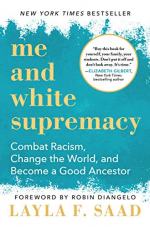
|
| Name: _________________________ | Period: ___________________ |
This test consists of 15 multiple choice questions and 5 short answer questions.
Multiple Choice Questions
1. The term “white centering” carries what meaning?
(a) The establishment of BIPOC and their perceived norms as the standards of comparison.
(b) The establishment of white people and their perceived norms as the standards of comparison.
(c) The disestablishment of all perceived norms as standards of comparison.
(d) The disestablishment of white people and their perceived norms as the standards of comparison.
2. How old does a Black boy have to be to begin to be perceived as an adult, according to Goff, et al. (142)?
(a) 10.
(b) 11.
(c) 12.
(d) 13.
3. The term “white saviorism” carries what meaning?
(a) People with white privilege cannot and should not save BIPOC.
(b) BIPOC can and should save people with white privilege.
(c) BIPOC cannot and should not save people with white privilege .
(d) People with white privilege can and should save BIPOC.
4. Saad notes that which of the following is a synonym for “optical allyship?”
(a) All of these.
(b) Ally theater.
(c) Antiracist work.
(d) Anonymous donation.
5. Which of the following does Saad identify as an example of relational tokenism?
(a) Claiming that having hired a BIPOC means a white-privileged person is racist .
(b) Claiming that having hired a BIPOC means a white-privileged person is not racist .
(c) Claiming that having married a BIPOC means a white-privileged person is racist .
(d) Claiming that having married a BIPOC means a white-privileged person is not racist.
6. In the book, the term “absolve” carries what meaning?
(a) Ascribe freedom and opportunity to.
(b) Remove guilt and responsibility from.
(c) Ascribe guilt and responsibility to.
(d) Remove freedom and opportunity from.
7. The term “woke” carries what meaning in the context of antiracist work?
(a) Being aware of racism and endorsing it.
(b) Being ignorant of racism and doing nothing with it.
(c) Being other than asleep in a bed.
(d) Being aware of racism and opposed to it.
8. Referring to a person by color is an example of which of the following?
(a) Metonymy.
(b) Anaphora.
(c) Synecdoche.
(d) Alliteration.
9. The term “tokenizing” refers to which of the following?
(a) Taking a single or a few isolated instances of a group as representative and inclusive of that group.
(b) Taking a majority of instances of a group as representative and inclusive of that group.
(c) Taking a totality of instances of a group as representative and inclusive of that group.
(d) Taking no instances of a group as representative and inclusive of that group.
10. What definition of “apathy” is used in the book?
(a) Lack of feeling, emotion, interest, and / or concern.
(b) Prevalence of feeling, emotion, interest, and / or concern.
(c) Having too many directions to follow.
(d) Lack of a direction to be followed.
11. Saad ascribes which of the following beliefs of the so-called Church of Color Blindness?
(a) Racism will go away through refusal to acknowledge and act upon perceived racial differences.
(b) Racism will go away through awakening consciousness of privilege and racial harm.
(c) Racism will go away through making amends in historical and current-day harm.
(d) Racism will go away through systemic and institutional change.
12. The term “cultural appropriation” carries what meaning?
(a) Adoption or exploitation of a nondominant culture by a dominant one.
(b) Integration or assimilation of a nondominant culture into a dominant one.
(c) Integration or assimilation of a dominant culture into a nondominant one.
(d) Adoption or exploitation of a dominant culture by a nondominant one.
13. In what year did Viola Davis accept the Sherry Lansing Leadership Award?
(a) 2018.
(b) 2019.
(c) 2017.
(d) 2016.
14. Which of the following movies does Saad identify as demonstrating white saviorism?
(a) Ferngully.
(b) The Last Airbender.
(c) Avatar.
(d) Pocahontas.
15. The term “optical allyship” carries what meaning?
(a) Allyship that serves primarily to provide glasses and contact lenses.
(b) Allyship that serves primarily to give the “ally” a platform.
(c) Allyship that serves primarily to give BIPOC a platform.
(d) Allyship that serves primarily to remove the “ally” from a platform.
Short Answer Questions
1. The term "misogynoir" carries what meaning?
2. Saad cites Spike Lee as defining the “magical negro” in what way (136)?
3. The term “fetishizing” carries what meaning?
4. Which of the following does Saad exclude from reasons that white-privileged people do not get to determine whether they are performing allyship?
5. Saad defines racism as which of the following?
|
This section contains 814 words (approx. 3 pages at 300 words per page) |

|




